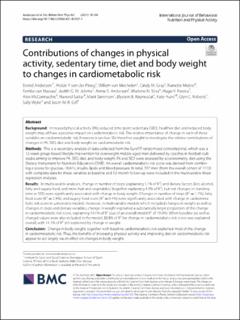| dc.contributor.author | Andersen, Eivind | |
| dc.contributor.author | van der Ploeg, Hidde P. | |
| dc.contributor.author | van Mechelen, Willem | |
| dc.contributor.author | Gray, Cindy M. | |
| dc.contributor.author | Mutrie, Nanette | |
| dc.contributor.author | van Nassau, Femke | |
| dc.contributor.author | Anderson, Annie S. | |
| dc.contributor.author | Silva, Marlene N. | |
| dc.contributor.author | Pereira, Hugo V. | |
| dc.contributor.author | McConnachie, Alex | |
| dc.contributor.author | Sattar, Naveed | |
| dc.contributor.author | Sørensen, Marit | |
| dc.contributor.author | Hunt, Kate | |
| dc.contributor.author | Wyke, Sally | |
| dc.contributor.author | Gill, Jason | |
| dc.contributor.author | Jelsma, Judith G. M. | |
| dc.contributor.author | Røynesdal, Øystein B. | |
| dc.contributor.author | Roberts, Glyn C. | |
| dc.date.accessioned | 2022-03-22T21:21:05Z | |
| dc.date.available | 2022-03-22T21:21:05Z | |
| dc.date.created | 2022-02-19T19:12:05Z | |
| dc.date.issued | 2021 | |
| dc.identifier.citation | International Journal of Behavioral Nutrition and Physical Activity. 2021, 18(2021), Artikkel 166. | en_US |
| dc.identifier.issn | 1479-5868 | |
| dc.identifier.uri | https://hdl.handle.net/11250/2986919 | |
| dc.description | This article is licensed under a Creative Commons Attribution 4.0 International License, which permits use, sharing, adaptation, distribution and reproduction in any medium or format, as long as you give appropriate credit to the original author(s) and the source, provide a link to the Creative Commons license, and indicate if changes were made. The images or other third party material in this article are included in the article’s Creative Commons license, unless indicated otherwise in a credit line to the material. If material is not included in the article’s Creative Commons license and your intended use is not permitted by statutory regulation or exceeds the permitted use, you will need to obtain permission directly from the copyright holder. | en_US |
| dc.description.abstract | Background: Increased physical activity (PA), reduced time spent sedentary (SED), healthier diet and reduced body weight may all have a positive impact on cardiometabolic risk. The relative importance of change in each of these variables on cardiometabolic risk, however, is unclear. We therefore sought to investigate the relative contributions of changes in PA, SED, diet and body weight on cardiometabolic risk.
Methods: This is a secondary analysis of data collected from the EuroFIT randomised controlled trial, which was a 12-week group-based lifestyle intervention for overweight middle-aged men delivered by coaches in football club stadia aiming to improve PA, SED, diet, and body weight. PA and SED were assessed by accelerometry, diet using the Dietary Instrument for Nutrition Education (DINE). An overall cardiometabolic risk score was derived from combining z-scores for glucose, HbA1c, insulin, lipids and blood pressure. In total, 707 men (from the overall cohort of 1113) with complete data for these variables at baseline and 12-month follow-up were included in the multivariable linear regression analyses.
Results: In multivariable analyses, change in number of steps (explaining 5.1% of R2) and dietary factors (less alcohol, fatty and sugary food, and more fruit and vegetables) (together explaining 4.5% of R2), but not changes in standing time or SED, were significantly associated with change in body weight. Changes in number of steps (R2 = 1.7%), fatty food score (R2 = 2.4%), and sugary food score (R2 = 0.4%) were significantly associated with change in cardiometabolic risk score in univariable models. However, in multivariable models which included changes in weight as well as changes in steps and dietary variables, change in weight explained a substantially larger proportion of the change in cardiometabolic risk score, explaining 14.1% of R2 (out of an overall model R2 of 19.0%). When baseline (as well as change) values were also included in the model, 38.8% of R2 for change in cardiometabolic risk score was explained overall, with 14.1% of R2 still explained by change in weight.
Conclusion: Change in body weight, together with baseline cardiometabolic risk explained most of the change in cardiometabolic risk. Thus, the benefits of increasing physical activity and improving diet on cardiometabolic risk appear to act largely via an effect on changes in body weight. | en_US |
| dc.language.iso | eng | en_US |
| dc.subject | body weight | en_US |
| dc.subject | cardiovascular health | en_US |
| dc.subject | physical activity | en_US |
| dc.subject | sedentary time | en_US |
| dc.title | Contributions of changes in physical activity, sedentary time, diet and body weight to changes in cardiometabolic risk | en_US |
| dc.type | Peer reviewed | en_US |
| dc.type | Journal article | en_US |
| dc.description.version | publishedVersion | en_US |
| dc.rights.holder | © The Author(s) 2021 | en_US |
| dc.source.pagenumber | 13 | en_US |
| dc.source.volume | 18 | en_US |
| dc.source.journal | International Journal of Behavioral Nutrition and Physical Activity | en_US |
| dc.identifier.doi | 10.1186/s12966-021-01237-1 | |
| dc.identifier.cristin | 2003683 | |
| dc.description.localcode | Institutt for idrett og samfunnsvitenskap / Department of Sport and Social Sciences | en_US |
| dc.source.articlenumber | 166 | en_US |
| cristin.ispublished | true | |
| cristin.fulltext | original | |
| cristin.qualitycode | 2 | |
